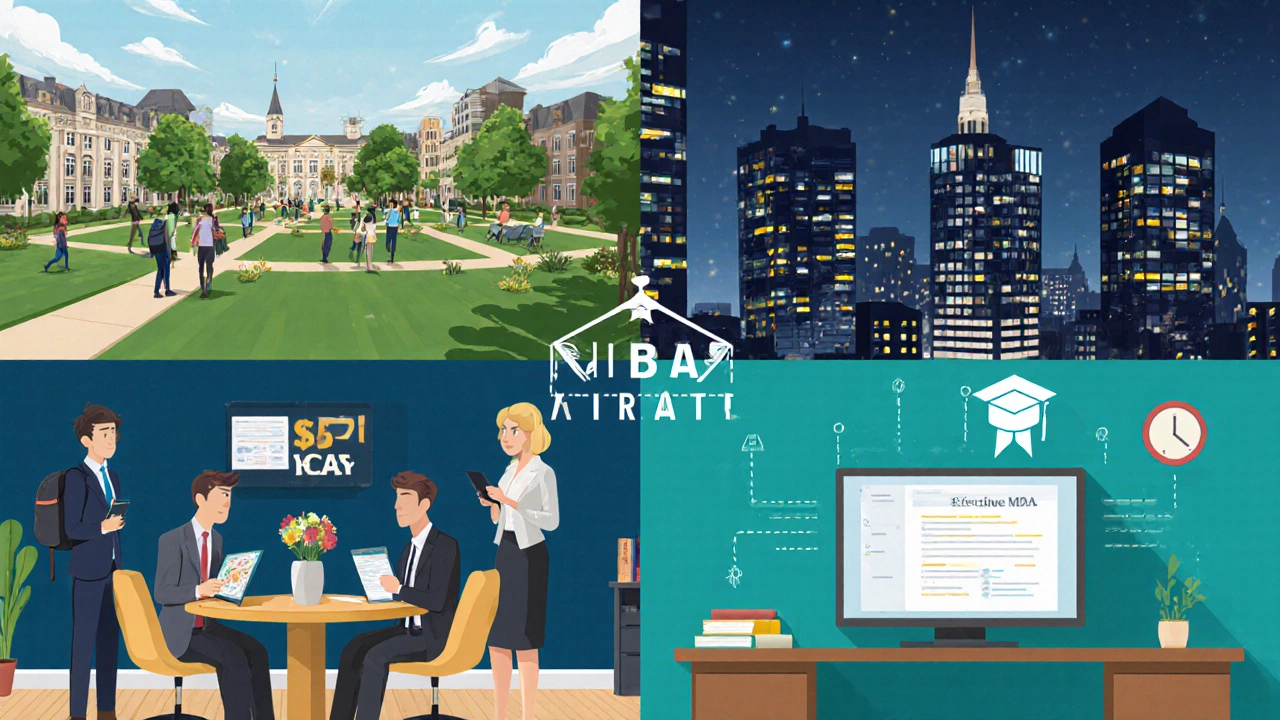How Much Does an MBA Really Cost in 2025?
 Oct, 18 2025
Oct, 18 2025
MBA Cost Calculator
Calculate Your MBA Investment
Estimate total costs including tuition, living expenses, and opportunity cost for different MBA programs
Your MBA Investment
Tip: Consider part-time or online options to reduce opportunity cost and maintain income while studying.
When you start weighing an MBA, the first question is almost always the same: MBA cost. Numbers jump from $30,000 to well over $150,000, and the reasons behind those gaps aren’t always obvious. This guide breaks down every line‑item you’ll see on an MBA price tag, compares the major program formats, and shows you how to figure out whether the investment makes sense for your career.
Key Takeaways
- Full‑time programs in top U.S. schools average $120k, while online options can be under $30k.
- Living expenses often add 30‑50% to the tuition bill, especially in high‑cost cities.
- Financial aid (scholarships, employer sponsorship, loans) can shave $20k‑$50k off the total.
- Average ROI for a U.S. MBA is a 3‑5 year payback period, but it varies by industry and geography.
- Choosing a lower‑cost school or part‑time schedule can reduce debt without sacrificing career gains.
MBA is a graduate degree focused on business management, finance, leadership, and strategy. It comes in several delivery formats, each with its own cost structure.
What Makes Up the MBA Price Tag?
Beyond the headline tuition figure, expect to budget for these recurring items:
- Tuition: the core academic fee. In the U.S., top‑tier schools charge $115k‑$135k for a two‑year full‑time MBA.
- Mandatory fees: technology, health services, career services, and lab fees can add $2k‑$6k per year.
- Living costs: rent, food, transportation, and insurance. In cities like New York or San Francisco, monthly expenses range $2,500‑$4,000.
- Books & supplies: $1,000‑$2,000 per year, though many schools now use digital resources.
- Opportunity cost: the salary you forego while studying. For a professional earning $90k, two years out of the workforce equals $180k in lost earnings.
Cost by Program Type
| Program | Typical Tuition | 2‑Year Living Cost | Other Fees | Total Approx. |
|---|---|---|---|---|
| Full‑time MBA | $115,000 | $80,000 | $5,000 | $200,000 |
| Part‑time MBA | $90,000 | $60,000 | $6,000 | $156,000 |
| Executive MBA | $130,000 | $40,000 | $7,000 | $177,000 |
| Online MBA | $30,000 | $30,000 | $3,000 | $63,000 |
These figures are averages. Elite schools (Harvard, Stanford) sit at the high end, while regional universities or public schools can be 40‑60% cheaper.

Geographic Price Differences
Where you study matters as much as how you study.
- United States: Highest tuition, especially for private Ivy‑League institutions.
- Canada: Tuition for domestic students averages CAD 45k (~$34k USD) for two‑year programs; international students pay about CAD 80k.
- Europe: Many public schools charge €10k‑€20k for EU residents; non‑EU fees can reach €30k‑€45k.
- Asia: Top schools in Singapore and Hong Kong charge $45k‑$70k, while Indian Institutes offer programs under $20k.
Financial Aid Options
Reducing the out‑of‑pocket amount is possible with a mix of scholarships, loans, and employer help.
Scholarships are merit‑based (GMAT score, leadership) or need‑based. Top schools award $20k‑$40k per student each year.
Student loans in the U.S. can cover up to 100% of tuition, but interest rates hover around 6‑8%.
Employer sponsorship is common for Executive MBA candidates-companies may cover 50‑100% of tuition in exchange for a commitment to stay for a set period.
When you add all aid sources together, the net cost for a typical two‑year U.S. MBA drops from $200k to roughly $120k‑$150k for many students.
Calculating Return on Investment (ROI)
ROI isn’t just a buzzword; it’s a concrete way to see if the price tag pays off.
- Determine total cost (including opportunity cost).
- Estimate post‑MBA salary increase. Average bump for U.S. graduates: 60‑70%.
- Use the simple payback formula:
Payback Years = Total Cost ÷ (Annual Salary Increase)
Example: Total cost $150,000, expected salary gain $40,000 per year → payback in 3.75 years. Most alumni see a positive net gain within 5 years.

Tips to Trim Your MBA Expenses
- Target schools with strong scholarship funds; apply early.
- Consider part‑time or online formats to keep working and offset opportunity cost.
- Negotiate tuition reductions based on competing offers.
- Leverage employer tuition‑reimbursement programs; some cover 100% up to a cap.
- Choose a location with lower living costs; many Midwest U.S. schools offer comparable ROI for a fraction of the expense.
Bottom Line
The price of an MBA in 2025 spans a wide spectrum, from under $60k for a reputable online program to over $200k for a full‑time Ivy‑League experience. By dissecting each cost component, comparing program formats, and factoring in financial aid and ROI, you can decide whether the investment aligns with your career goals and financial situation.
Frequently Asked Questions
What is the average tuition for a full‑time MBA in the U.S.?
For the 2025 academic year, top‑tier U.S. schools charge between $115,000 and $135,000 in tuition for a two‑year full‑time MBA.
Can I work while studying for an MBA?
Yes. Part‑time and online MBAs are designed for working professionals, allowing you to keep a salary that offsets the opportunity cost.
How much can scholarships reduce my total cost?
Merit‑based scholarships at elite schools often range from $20,000 to $40,000 per year, potentially slashing total expenses by 20‑30%.
Is an online MBA worth the lower price?
Many employers view reputable online MBAs on par with traditional programs, especially when the school is accredited. ROI depends on reputation, networking opportunities, and the industry you target.
What is the typical payback period for an MBA?
Across the United States, the average payback period ranges from 3 to 5 years, assuming a 60‑70% salary increase after graduation.